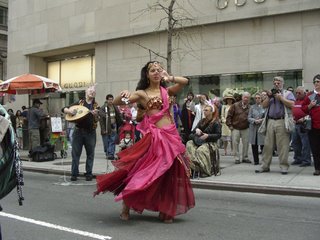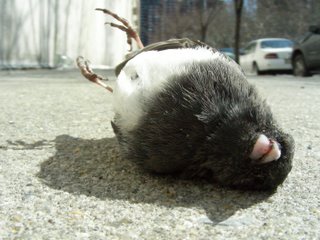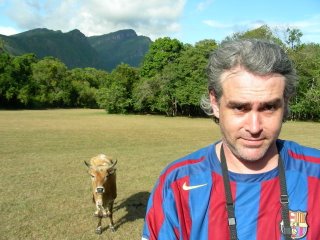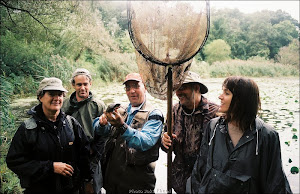
What is beauty, exactly: A bribe ? A reward ? Or the promise of something eerily different... This (beautiful) image (c) Val Druguet @ last week's Easter Day Parade.
Friday, April 28th. So-called 'Earth Day' has come and gone and Val and I stayed at home (28th and 7th) and celebrated by reproducing. Afternoon delight. Given all the ambient Gaia vibe going on outside we thought it an appropriate homage to springtime. What with Easter, Passover, spring break... We partied accordingly. Our right of spring. You party therefore you are. Our ancestors agree.
Rest of the time we've been stuck, per usual, our faces in the dirt, rummaging through the understory of New York City's remaining wilderness. Naturalists at large, birding, butterflying, botanizing, come raindrop or sunburn. Guess what: in the past 2 weeks bonanza's of new wildflowers have sprung. Virginia Blue Bells, white Wood Anemone, sulfur-toned Sessile Bellworts, wild Pink Azaleas... Eye-candy! Big apple of our eye!
In scientific nomenclature, that’s Mertensia virginica, Anemone quinquefolia, Uvularia sessilifolia, Rhododendron nudiflorum. Annie Dillard says that seeing is an act of verbalization - you visualize what you can call out by name.
I see things twice. Once in English, once in Latin. I’m stereo-lingual. Either that or permanently drunk. In my own, personal idiom, the above list can also translate as ‘soft leathery petals, pools of pepper-scented honey, pert pistils and erectile stamens, magic carpets of ocular titillation’. Simple sensual stuff, the opposite of downtown traffic. The dark menstrual rose of red bud. Lawn violets as grass people. The Crayola-crayon-green shock of the Norway maple bud. One large psychedelic megaboomblast color explosion (And I'm still stuck in the sixties…)
The flower list thickens: wild ginger, may apple, smooth yellow violet. I.e.: Asarum canadense, Podophyllum peltatum, Viola pubescens… How polite. These names come with a surname. Respectability. Attribution of kinship. The beauty of the Linnaean language (aforementioned Latin names) is that it describes a being’s relation to the world, its bloodline. It attempts to tell the full story of a plant or animal’s place in time and evolution. I believe it speaks to us of the relationship between a being and the sum of all Life. First the Species, then the Genus to which it and others belong, then the Family to which it and even more species and genera belong. That’s like daughter/son, mother/father, grandmother/father… The Linnaean system reads like a recognition of ancestry, a tribute to history and to belonging. A language of community. I party, therefore I am.
Likewise, the beauty of the common name lies in the story it tells of our relation to the plant, thus of our dialogue with nature at large; for hundreds of thousands of years, wildflowers were our natural medicine cabinet, our Alibaba’s cave of natural remedies. Toothwort ? The plant that cures our tooth ache. ‘Wort’, from the old English equivalent to ‘root’, meaning herb, which is actually from the French ‘herbe’. Confused ? A solution is in the works.
A current project intends to supplement all common and Latin names with barcodes and phylogenetic codes. Numbers. Zeros and Ones. Similarly, Bill Gates and his buddies were caught on C-span by yours truly at their annual nerd fest at Davos this past winter; they were reveling in the idea that thanks to the information revolution the entire planet would soon be entirely translated into digital, replicated, virtually cloned. With zeros and Ones.
Onto silica we jump! Hurry! Quick! Before we run out of the original!
Come to think of it, ever notice how many people around you (that includes me and Val) are actually running around with digital cameras these days? And all these dodos with mobile phones that take digital snapshots? Then upload them onto their computers (confer kodak moment above)... Seems to me the whole world has turned into one giant photography slave feeding binary information to a machine. O Terminator, where art thou ?
I predict that some day soon, even our conversations and gossip will be reduced to the Pythagorean ideal. Plus or minus. Yes or no. Nothing but numbers! We’ll all speak Math, the so-called universal idiom. Maybe then we’ll finally realize how much language really counts. HA!
Back to my main point: Angiosperms and the beauty thereof. Val and I will readily admit to (again) spending all of our time flirting with wildflowers and other life in our usual boudoirs: Alley Pond, Queens; the North woods of Central Park; Inwood; Prospect Park. We walk around like drunken idiots (at least I do), foaming at the mouth, slaves to our senses and built-in endorphin factories; we fumble through the budding forests and botanical gardens of NYC, snorting crabapple, cherry, hyacinth, lilac, tulips with names like ‘corsage’ and ‘day dream’… We’re stoned out of our minds. At the sheer sight and smell of a bunch of male and female sexual organs glued to a freakin’ branch. The question is: Why ?!
To find out, we went to this lecture last night on the evolutionary roots of beauty at the American Museum of Natural History, given by renowned ecologist Gordon Orians. According to this fine gentleman what Val and I are really after (subconsciously) is the fruit and nourishment of all life. Beauty as food - and vice versa. When we go naturalizing for flora, we’re actually ‘hunter-gathering’. And guess what - it plays out just like foreplay. Each new species, shape or scent or form we bump into brings on a rush of pleasure, a soothing flush of emotion; with every new epiphany with some gaudy shock of biodiversity comes a heartfelt reward (important word in the following paragraphs), i.e.: a micro-orgasm (O Epicure!).
All of this has a purpose, of course. Namely, survival.
Orians hypothesizes that the human species (like the bowerbird) is in many ways addicted to the fancy and the colorful, because as primates we relied for eons on our powers of discernment and appreciation to find food and survive in the deep dark woods of our primeval ancestry. Oooo! Ripe red fruit! Apple of my eye! Grunt! Hoot! Whoop!
Yup, our delectation in Beauty is a de facto built-in reward system. We evolved (rule of thumb) to enjoy doing what is good for us, i.e.: that which ensures our continued existence. Survival of the prettiest! Confer all nervous sensations produced by intercourse. Reproduction. “Star rockets in flight…” Beauty is what we survive on. We compete for it: Oooo! Ripe red fruit! Grunt! Punch! Eviscerate! Stab! Steal! Whoop!
How odd: this whole theory of beauty rings like a projection – and justification- of our own belief and value systems. (Not mine, the one of our current establishment, pumped as it is on its own ideology and practice of social Darwinism and fanatical belief in competition, contest and prizes). Beauty, the trophy.
The rarer the better, of course. The louder the 'Eureka!', the bigger the buzz. We pay attention to that which is uncommon, deviant, off the bell-curve. Mutational. Beauty, whose requisite is variance, diversity, change. Evolution!
‘Beauty, concludes Orians, is something that lies in the ‘adapted’ mind of the beholder.’ (Sounds like E.0. Wilson's "beauty lies in the genes of the beholder"). As a species, he adds, we have even figured out how to use it (beauty) to our advantage, as currency, for status. For sex and for power. The more of it we hoard and keep (priceless art or expensive roses) and display (enter the Rolls Royce and the Strip-dancers), the richer we are, the more seductive, the more mates, the more offspring. Yadda-yadda. The more of everything. Sounds to me like shopping at Wholefoods. Glutinous out-of-control bowerbirds. Oh dear… Did liking red apples lead us one day into Iraq? It led us out of the Garden!
So we have it: spring wildflowers are as erotic as cheesecake. Sweet, refreshing and fat with visiting bumblebees that suck themselves through the crisp, spring air (Bees don’t ‘fly’, they create vortexes with their wings into which their bodies are then hoovered, silently).
And so I wonder: since beauty stands for survival and continuity, could reveling in the splendid and the sublime (and the glory of wildflowers) be our last shot at eternity - apart from building pyramids and cryogenics? For us, meager species, cursed with the conscious and unspeakable fear of death ? I.e.: is beauty something we use to vacuum ourselves into tomorrow, into the afterlife ? Are we like bumblebees? Is beauty our vortex ? Our aspiration?
I’ll be honest with you. And a tad intellectual (yawn). I agree with Professor Orians - and I disagree. Because I am both a dilettante reductionist and a devout structuralist, depending on the hour. Sure, beauty can be a reward, a trophy (the selfish point of view); but it can also be that which helps to create something greater than the sum of all participating components (the selfless point of view). Beauty is a whisper, a promise, an invitation to something 'larger'. A tantalizing perfume, a hook that grabs us by the senses and hauls us into something bigger than ourselves: an emerging order, with emergent properties. An afterlife! When we answer the call of beauty we are participating in a megaverse that is greater than the sum of all beings, molecules, atoms. Ultimate eye-candy!
Very unfortunately, this ‘megaverse’ to which I am referring is something to which we are destined to be blind. We cannot see it for we are stuck inside of it. Just as a carbon molecule trapped within a sugar atom will never know just how creatively sweet he or she is, we remain clueless as to what emanates from the assemblage of so much beauty in the world and cosmos around us. Similarly, like brain cells in a brain, we have no idea how collectively conscious (or not) we really are.
Take artists. They pollinate society by ferreting out new ideas, flying them from gallery to gallery. Just like bees pollinate the woods around us - by buzzing from flower to flower. Poetry, in motion. Will never the read the totality of the poem it is helping to write.
What I’m getting at (am I?) is that a wildflower (or an apple) is the infra of another, supra-world to come. A symbol not of fertility, but of yet more fertility, just around the corner - to us unknown. Today’s creativity, tomorrow’s creatures - to us unknown. Sure, beauty can signify fruit and sex and pleasure and plenty in the moment; it is also an invitation for us to partake in the creation of an invisible future. As yet unseen - and unnamed. Did dinosaurs dream of turning into birds? To contemplate beauty takes courage. It is potential chaos. It is uncertainty. It is the seething community of “Fornikation” so abhorred and adored by Werner Herzog. Ever been into the rainforest ? It is more than beautiful. It is the sperm and egg of tomorrow’s sublime.
For my Ye'kuana friends (a tribe in southern Venezuela), there is Wanato, the Spangled Cotinga, an electric blue and plum-throated bird species of the rainforest canopy. Today's iridescence of the 'birdman' - he who invented beauty in a time long before ours.
Beauty as process. Through today’s wildflowers and berries and apples and other plays and works of art we are invited to act. To take action. Beauty as Verb. To be beautiful. Our chance to evolve. When I stare at a wildflower, or a jungle, I’m looking straight through an open door of endless possibility, into tomorrow’s design. Let go! To acknowledge beauty everywhere (in a worm, a slug, a snake) is to agree to be a part of that process of evolution and life. Ultimately, it is to accept and acknowledge death. The vortex ahead. We too, have the potential to be beautiful.
Which reminds me: A week ago Sunday Val and I did not go “shopping” for wildflowers in the understory. For once. Because another pagan festival snatched us en route. The Easter day hat parade in Midtown, on 5th Avenue - Capital of all things perpendicular and monolithic and perfect. Trump Tower Road. If only Plato had lived to see it! We took our niece, Olivia, who is a freshwoman at Barnard’s, originally from Seattle. Her first year in New York. Pastel pinks and blues and greens were everywhere. The air was fresh with sunshine and the smiles of a thousand imbeciles.
You’ve never been ? This is how it works (or rather, ‘plays out’): each person has an orgy going on his/her head. That is to say, a whole bunch of people show up in front of St Patrick's Cathedral with weird, hand-crafted hats that tower into the air, replete with built-in green gardens on platforms smothered in pink flowers and hosting wired mobiles of dangling red butterflies and bluebirds and stuffed bunnies with eggs and the like... One guy even had a living parrot – an African Gray- on his hat; the bird responded by chewing up all of the hat’s plastic biodiversity. And then there’s everybody else. All the you’s and the me’s who show up to ogle the guys with the hats. And take pictures with digital cameras. And hoot “how beautiful!”
Look deeper. Easter Day Hat parade is the only parade in NY where the military don’t show up or death is not on full display (Halloween has ghosts, Saint Patty’s got soldiers with guns. And Bloomberg). Accordingly, it’s the only parade where people are neither forced nor obliged to walk in a straight line nor crowd and scrunch-up behind police barriers. For once, a real day off. Walking is random, circular, disorderly. Non linear and chaotic. People own the street. People go Bumpeteebump. They say excuse me and exchange innocuous looks. The entire crowd is like matter in a state of plasma, before stuff signs up to be an atom or a molecule. Free, living energy. Pre Big-Bang material. “Sky rockets in Flight…”
At first I stand there with my mouth open. Goop! I bask in the reflected glory of seeing no mission, no target, no objective in the crowd, other than the freedom of movement itself. Bakunin would have loved this. Forgive the following snippet of sexist speculation but I also see this parade as something exquisitely feminine. Intrinsically creative. Easter=Ishtar=Fertility Goddess, she who rises in the East. As in Estrogen. Don’t believe me ? Ask Google.
I just finished reading a recent study about army ants (the ones in the tropics that swarm by the millions in vast columns and devour and disassemble stuff en route). In it, the authors show how crowds (like ants) spontaneously form lines and columns as a means of collective discipline and order and all around beneficial regimentation. Like people on a side walk going to work in Manhattan, ants spontaneously begin to form lines going one way, lines going the other, in the heat of ant rush-hour (ants don't need traffic cops - they self organize). It is the collective intelligence of crowds to thus reduce bumps and run-ins and get people to wherever people have to go in as short amount of time as possible. With the least amount of hassle possible. Soooooo clever.
Not so at the Easter day hat parade! This thing seems brainless, like watching bumper cars on cocaine (or me and Val rambling around NYC looking for wildflowers); participants stumble about in a state of sheer anarchy. The ultimate duh-fest. Nobody gets angry (except for one very up-tight hag whom I overhear reprimanding ("shame!") a black dude for showing up in medieval drag à la Lord of the Rings).
So just on this day, it seems, New Yorkers are allowed to be something other than neat and orderly and efficient (and stressed out); they get to transcend the grid from within, supercede the machine, to be other than just a competent component - or cog. More than just a 0 or a 1, flying around the motherboard of Mannahatta... Thank G*d for Easter ! On this blissfuly confused day of Spring, our Euclidian geometry collapses. Newton is dead. Descartes never existed. What a beautiful mess, Mr. Orians !
Three years ago, at my first Easter Day Parade, in the middle of all this gooey happiness there was one person, however - a man - attempting to steer and control traffic. He was old. Petrified. A patriarch ? He was standing quite appropriately at the corner of 5th and 50th street. At an intersection. At a perpendicular within the Grid. He had a big sign that read something about the apocalypse and Jesus Christ our savior. He was an evangelist. He was shouting out prophecy and doomsday. “Repent ! Blasphemers and sinners ! For the day of reckoning has come…” I stared at Val. Val stared at me. This man was directing traffic alright, spiritual traffic. Seemed he couldn’t stand all this disorderly pagan conduct, these hearts and souls lost in the leisure of uncertainty. And beauty. Had we disrupted his grid ? Ever the semiologist (one who reads signs) and the devout Jungian, I suddenly realized the Christian cross itself can look something like a mathematical, X Y axis. Religion, the Cartesian system? Bear with me, look at a cross, or make one with your fingers: it's a perpendicular, right? It evokes 'up and down', 'right vs. left', plus or minus, the superior and the inferior. Order, hierarchy, submission (the stuff of crucifixion). Yuk.
As a quietly rebellious teen in the 70’s I used to enjoy when Carl Sagan would rant on TV about the Pythagoreans’ belief in a perfect, immortal, non existent, world of mathematical ideals. I remember him explaining it as a means for Greek citizens at large to explain and justify and legitimize their own value system – a so-called democracy that would permit and rationalize slavery. Inferior people in a superior world.
Mr. Gates, meet the Greeks. Or come to the NYC Easter Hat parade.
Speaking of numbers, some of you may know of William Wallace, NYC’s most cheerful historian and talking head on the PBS series “New York”. In it he postulates that the famous grid and number system of New York City (are you listening, Mr. Gates?) were devised to make it easy for inbound illiterate people from all over the world who couldn’t speak English to find their way. Maybe it just turned out that way. Maybe what was really going on was more conspiratorial. Two years back I read a Masters thesis by a geography student who theorized that the Manhattan Grid (the first of its kind, and the first to be born of the Industrial Revolution (that which defecates on the Commons) and the age of Modernity (that which urinates on the past)) was in fact a planned, strategized, well thought-out effort by the power system to control and file the populace with easy access to their numbers. People had become numbers. Order. Hierarchy. Submission. Yuk !
So Pythagoras rules (he who hath a lithp and pithes in public, hence ‘Pith-agoras’; Agora, from the Greek meaning ‘public place’, all of this according to an old and good friend of mine, my older brother Andrew). As do computers all assembled into one automaton, like the one I’m plugged into right now, the one filing all my thoughts as 0’s and 1’ as I e-blast this rant off into cyberspace. O Morpheus!, where the fcuk art thou?
Joseph Campbell used to say computers were like an old testament god - a lot of rules and no mercy.
One last item: back in 2003, most of all hats at the Easter Day parade were signs of protest against the war in Iraq. People had created imaginative battle scenes on their heads using toy soldiers smothered in ketchup holding flowers and little signs that read: “make love, not war”. Rather appropriate for an Easter day Parade! This year, 2006, all seems to have been forgotten. Or fully accepted. Or simply acknowledged. As in ‘Mission accomplished’. Anesthetized. PC. Clean.
Wait a minute ! There's this one damsel, wholesomely revealing in her Arabian attire, belly-dancing in the middle of the crowd (confer Kodak moment above) with some dude playing some middle-eastern music in the background, from the sidewalk. I wonder: this Princess Leia prancing around the pavement... a trophy? She's straight out of an old Cecil B. DeMille flick. I believe in the power of the unconscious, meta-communication, Freudian slips of the collective tongue. This woman might be the unknowing and unspeakable sign that we are proud to have pillaged and plundered Mesopotamia with shameless success. She embodies the prize. We have returned from battle, victorious. With loot - the smooth skin and buoyant hips of a young dancing Arab. Beauty as reward. O Wildflower from ‘A Thousand and one nights’! Symbol of fertility. Mother of all virgins. Eye-Candy from the East. Slave. Apple of our eye.
Ishtar ! The spirit of Easter, fully captured... And she's dancing like she's the best 'number' in town.
aim before you shoot!
Dave Rosane and Val Druguet





.jpg)

